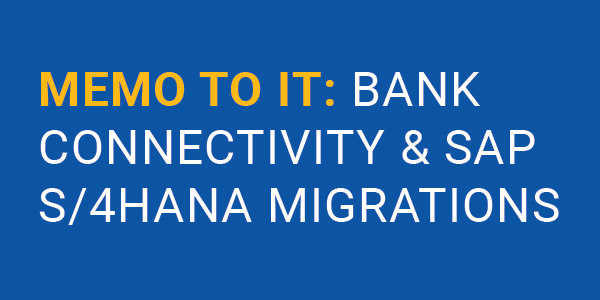This article appears in SAPinsider Magazine – Summer 2024 edition:
In a turbulent global economic climate, CFOs and other finance leaders must use every tool at their disposal to keep pace. Organizations must have the agility to respond to shifting market conditions and internal priorities.
However, finance leaders often struggle to make informed data-driven decisions for their organizations because they do not have all the information they need, or that information is not accessible to them when they need it. Multiple, disjointed systems lead to disaggregated data and information silos, which is what
Kyriba calls Liquidity Gridlock.
These finance leaders need a holistic view of their full company to be able to make strategic decisions for their business. One of the most critical areas where finance leaders must have this information is visibility into their liquidity. CFOs need to have a clear understanding of their cash and borrowing capacity to better position their organization for long term success.
Companies like Kyriba help mitigate these issues by delivering the most sophisticated capabilities for treasury, risk management, payments and working capital.
Visibility Vs. Actionability
One critical mistake that organizations often make is confusing visibility and actionability. While it is important to have a clear, end-to-end view of an organization’s financial realities, all the information is not helpful if CFOs are unable to pull the appropriate levers to respond to changes like an interruption in a payment cycle or shifts in currency rates, leaving them in a state of liquidity gridlock.
“CFOs are faced with a number of challenges and most businesses don't utilize their technology effectively to unify the data and insights across the enterprise. Being able to establish information pathways in and out of systems like SAP to support those actionable decisions is incredibly important. This is why customers choose to work with Kyriba. We empower CFOs by giving them a comprehensive understanding of their business and the confidence to take the right actions," said Melissa Di Donato, Chair & CEO of Kyriba.
Many organizations work to ensure visibility within their financial landscape but fail to operationalize those insights. When visibility and actionability come together, CFOs are able to model potential impacts of changes or disruptions and then act.
Whether they need to work with suppliers on different terms of payment, borrow cash, or protect assets from currency models, a solid data foundation can bridge the gap between visibility and actionability. This gives CFOs the confidence to make decisions on which actions to take and know what the outcomes will be.
Liquidity
Liquidity is one of the most important focus areas for CFOs as they aim to ensure their business is agile and scalable. In fact, a
report from Kyriba found that corporate liquidity for US companies was $3.46 Trillion at the end of 2023, a year over year increase of $180 Billion. Having sufficient liquidity allows businesses to drive innovation and fund essential projects. Companies need to be able to harness, manage, and then action liquidity to drive the performance of the organization to drive business strategy.
SAP can help with many of the issues leading to liquidity gridlock by acting as a single source of truth for all financial operations across an enterprise. However, organizations need solutions that connect their SAP instances with banks, trading portals, suppliers, and other third parties.
“True business transformation starts with taking the best of SAP and its ecosystem. With an organization like Kyriba as part of that interoperable system that surrounds SAP, we ensure that the insights, the impact and the flow of information is accurate so the office of the CFO can make informed decisions,” added Di Donato.
Reducing Risk
Beyond just allowing organizations to operate in a more agile manner, liquidity also plays an important role in reducing risk and exposure. Part of the liquidity plan for a finance team should include ensuring that the appropriate levels of control are in place. This ensures that only those with the proper approvals can make certain transactions, meeting audit requirements.
“We want to make sure that the person that enters payments is not the same person that can also edit the ledger. It’s important to maintain a level of control so that there is a uniform practice implemented across the organization, regardless of who is doing what, how many people we have in a certain region, how many hats they wear, and how urgent the payment request was,” said Bob Stark, Global Head of Market Strategy, Kyriba.
AI plays a critical role in streamlining how CFOs manage their finances, especially when it comes to forecasting and reducing risk. Kyriba’s AI features allow customers to increase predictability of cash, risk and liquidity decisions all while driving new levels of liquidity performance for its customers, including fraud detection.
Companies can leverage these AI-backed solutions to detect anomalies compared to past payments to identify potentially fraudulent activities. This is one of the top areas organizations are targeting for this technology, as nearly one third (33%) of respondents to SAPinsider’s recent AI and Automation in Finance Benchmark Report plan to add automation into cash management functions.
SAP Integration
Kyriba, which has the largest partner-focused treasury technology ecosystem in the world, has been innovating with SAP for years through its certified Kyriba SAP integration, which seamlessly connects SAP with Kyriba to automate the workflow between the two platforms.
Many SAP organizations have indicated that they are reticent about deploying any new technology while they are in the midst of their SAP S/4HANA deployment. This major project is either in progress or on the horizon for a large share of SAP companies. However, this may actually be an ideal time to review and update cash management practices.
In many cases, the organizations working on an SAP S/4HANA migration will want to overhaul their payment and treasury processes. Companies can save themselves significant headaches if they avoid migrating outdated processes full of customized workflows from their legacy SAP instances into SAP S/4HANA.
“When migrating from SAP ECC to SAP S/4HANA, many organizations are surprised to learn that the entire payments landscape has changed since they initially implemented. APIs, XML20022 format migrations, evolution of SWIFT's services and payment types, such as instant payments, make for a completely different payment experience. This is where working with Kyriba and the SAP project team together helps reduce costs and remove unexpected project barriers” said Stark.
The ideal time for organizations to review these systems is while the SAP landscape is already in flux and under review, as opposed to after the SAP S/4HANA implementation is completed.
It’s clear that the organizations that work with Kyriba and SAP are able to maximize their liquidity performance, giving CFOs the agility they need to drive innovation and value for their business.






